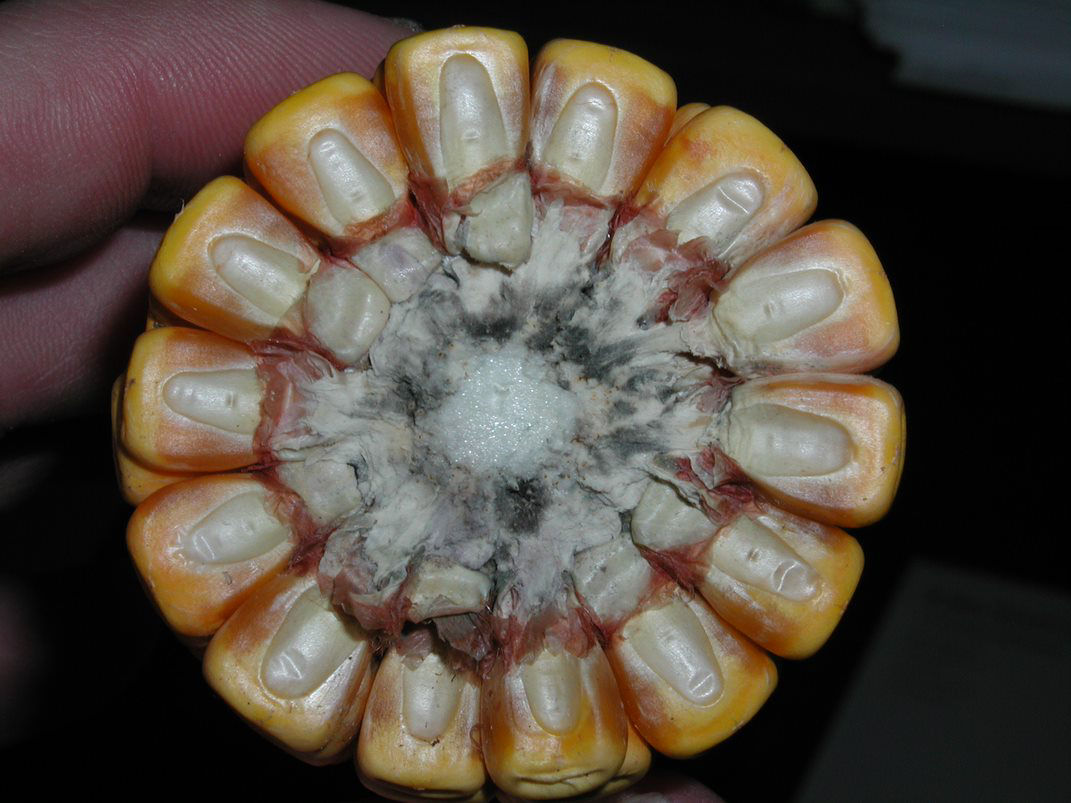5 MIN READ
Nigrospora Ear and Cob Rot
July 8, 2021
Nigrospora ear and cob rot is a fungal disease caused by Nigrospora oryzae. The disease can occur throughout corn-growing areas, although it is rarely seen. When the disease occurs, it often goes unnoticed until harvest. Although N. oryzae does not produce mycotoxins that are harmful to humans and livestock, like Aspergillus, Fusarium, and Gibberella that cause other ear rots, it can cause considerable damage to ears, kernels, and cobs, reducing yield and quality.
Disease Development
The disease occurs late in the season and is an indirect result of any biotic (living) or abiotic (non-living) factor that might hinder good crop development. N. oryzae is a weak pathogen that attacks plants already damaged or killed prematurely by drought, frost, root injury, diseases, and insects. Corn grown in soil with low fertility tends to be more susceptible to the disease because poor fertility may lead to premature plant death. Infection typically begins and becomes more severe at the base of the ear, although it can begin at the ear tip. The fungus survives year-to-year on corn residue.
Symptoms
Symptoms of Nigrospora ear and cob rot are seldom noticed before harvest. Notable symptoms include:
Dark gray or black mold (fungal mycelia) on and between kernels (Figure 1)
Small, black fungal spores on the surface of kernels, forming at the tip end of the ear (These spores can be removed easily by rubbing them with your finger) (Figure 2)
Kernels that are slightly bleached and have white streaks extending from tips to crowns
Infected ears that weigh less than healthy ears, are chaffy and have kernels that are loose on the cob
Kernels that can be easily pushed into infected cobs
Cobs with a brown, tattered appearance at the shank
Shredding of shanks, bases, and cobs during mechanical harvesting and shelling (Figure 3)



Management
Because N. oryzae attacks plants already weakened, management practices that promote general plant health may minimize the risk of the disease.
Select corn products with good stalk strength and a solid disease package to help decrease the potential of plants being killed prematurely by foliar and stalk diseases.
Reduce stress on plants by maintaining optimal fertility and effective insect pest management.
Avoid following corn with corn, especially under conservation tillage. N. oryzae fungal spores can overwinter on residue and under favorable conditions, increase the potential for the disease to develop in continuous corn.
Utilize proper drying and storage practices to help minimize further fungal growth in stored grain.
Sources
Corn Ear and Kernel Rots. 1991. University of Illinois Extension. RPD No. 205. https://ipm.illinois.edu/diseases/rpds/205.pdf.
Munkvold, G.P. and White, D.G. (Editors). 2016. Compendium of Corn Diseases. Fourth Edition. APS Press. The American Phytopathological Society, St. Paul, Minnesota.
Munkvold, G.P., Osweiler, G., and Hartwig, N. 1997. Corn ear rots, storage molds, mycotoxins, and animal health. Iowa State University. Extension and Outreach Publications. 24. https://lib.dr.iastate.edu/cgi/viewcontent.cgi?article=1025&context=extension_pubs.
Nigrospora ear rot. The Ohio State University. https://u.osu.edu/mastercorn/nigrospora-ear-rot/
Wise, K., Allen, T., Chilvers, M., Faske, T., Freije, A., Isakeit, T., Mueller, D., Price, T., Sisson, A., Smith, D., Tenuta, A., and Woloshuk, C. 2016. Ear rots. Corn Disease Management. Crop Protection Network. CPN-2001. https://cropprotectionnetwork.org/resources/publications/ear-rots
6005_S7